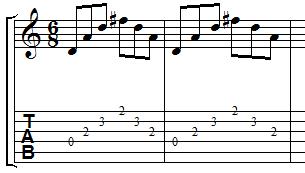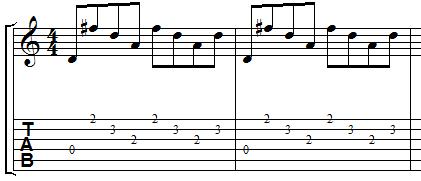Arpeggio
The word arpeggio comes from the Italian language and means 'broken chord'. An arpeggio on the guitar is when the notes of a chord are played one at a time. This can consist of ascending/descending through the notes of a chord or picking a specific pattern of notes. Below is an example of an arpeggio played on a D major chord:

In the above example you should use downstrokes whilst ascending through the chord and upstrokes whilst descending. Beginners may want to use downstrokes throughout but this should be avoided if possible.
Ascending and descending aren't the only way to play arpeggios. Below is a picking pattern played on the same chord:

The above example is a bit trickier but take the time to learn the picking pattern. The term 'picking pattern' can refer to the order of notes and the combination of downstrokes and upstrokes.
Once you've learnt a variety of chords and arpeggios you will find it easier to create your own simple riffs. Try choosing a different chord and playing an ascending/descending arpeggio, then make up your own picking pattern.